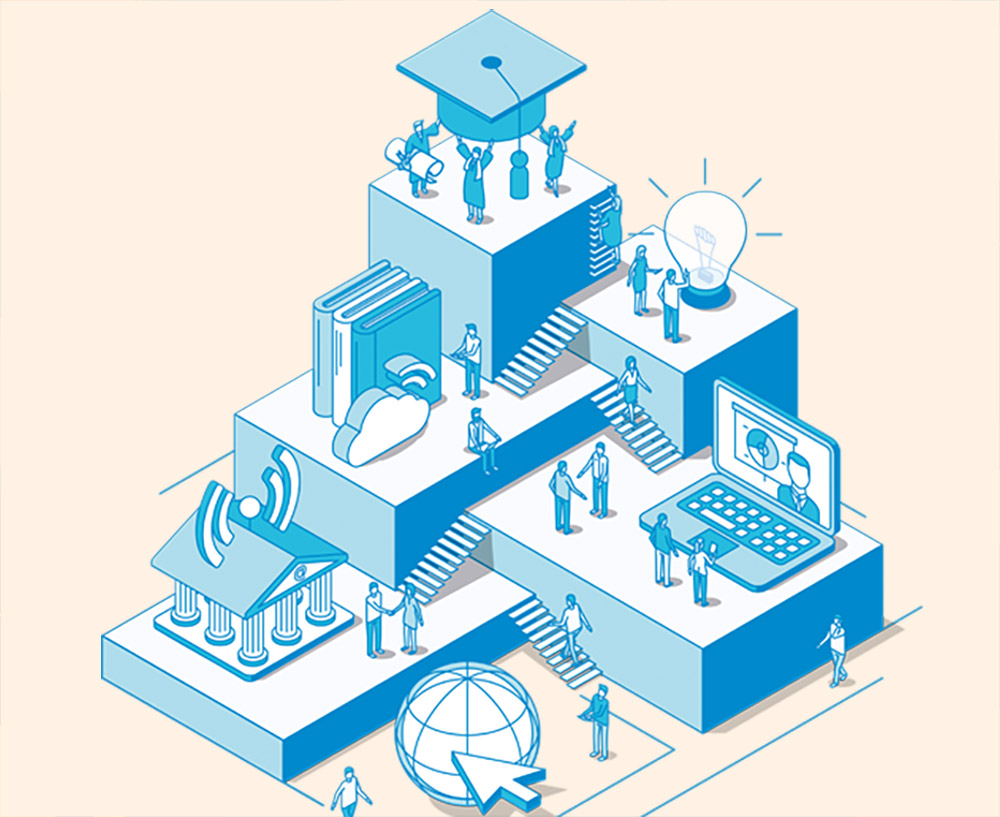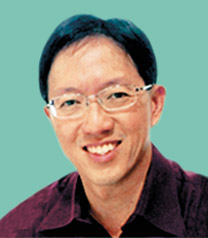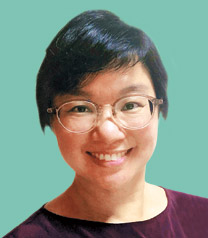Whither the University? And not just where is it, but when is it?
Dr Adrian W. J. Kuah and Ms Katrina Tan (Arts and Social Sciences ’98) reflect on how the higher learning experience of the future may transcend the campus setting — and why it should.

Imagine this. Ten years from now — maybe 20, maybe sooner — a visitor to Singapore asks a local for directions to the National University of Singapore. She is met with a quizzical look, as though the question makes no sense. The local gestures expansively around him at the cityscape and replies, “NUS? But all this — all of this — is NUS!”
Lower Kent Ridge Road. College Avenue West. College Road. Bukit Timah Road. These are the locations of the campuses of the National University of Singapore. But more than merely places on a map, for those who have spent any length of time in them, they are edifices far larger than their physical buildings. They hold meaning, memories and experiences that go beyond their stated objectives — a place for learning, a place of work. For many, they are where we went to school; a physical location where we dutifully trotted off to for four years to get an education. The “university”, for all its self-flattery that it is an institution that transcends the prosaic and the quotidian, has always been bounded by space and time. The language we use reflects that: “Where did you go to school?” And many of us refer to those years in our early 20s spent in a particular place as “the college or university years”.
But perhaps that will soon change. COVID-19 has shown us that it is possible to learn, take exams, hold discussions and get work done outside this container of the university campus. Instead of going to university, the university came to us, however remotely (in all senses of the word). We saw the opening of more access routes to learning, a greater focus on student engagement and motivation, a higher level of trust and reliance on self-directed learning (home-based learning, synchronicity and asynchronicity in teaching and learning), the provision of space and time for students to explore their interests outside the curriculum, etc. We saw what could be done when edutech became a necessity and not simply an alternative to be implemented in the near future.
However, the lifting of the Circuit Breaker1 and the gradual move through the phases has seen the reversion to the mean, rather than the forging ahead into the new normal. The question is, can and should we give up the ground we already conquered? Can we exploit the gains from the COVID-19 experience? Does the university need to be contained within a set of buildings at set locations where people go?
John Dewey, deemed the modern father of experiential education, spoke of the paucity of traditional education in Experience and Education (1938). Its imposition from above, external discipline, learning from texts and teachers, rote learning of skills, preparation for a remote future, and static aims and materials, all fail in preparing the young for future responsibilities, but instead inculcate “docility, receptivity and obedience.” Instead, he offered a progressive education based on his view that the social nature of mankind means that education is in itself a social process. As such, when education is treated as “intelligently directed development of the possibilities inherent in ordinary experience” — its potentialities are vast.
Where then, does this ordinary experience take place? Everywhere — within and without the traditional university campus. Dewey recognised that learning takes place in a variety of environments, and that while the school is a special one, nature and the social environment cannot be discounted. This harks back to his central premise that education is “a fostering, a nurturing, a cultivating standard form of social activity”, through “a process of sharing experience till it becomes a common possession”. Hence, education must transform its immature members from “uninitiated and seemingly alien beings into robust trustees of its own resources and ideals.” As such, education cannot be divorced from the purposes and practices of the community. It cannot be pigeonholed into specific locations over specific periods of time.
![]()
By sheer dint of locating the learning outside the classroom, the complexity we expect to see in real life is built into the learning environment. Multidisciplinarity and complex problem-solving segue seamlessly from knowledge acquisition.
LEARNING for real life
Technology has allowed the outside to be brought into the university — think of drone flights videotaping human and traffic flows in a city, or animations of volcanic eruptions. How about bridging the outside and the inside, beyond brief sojourns on learning journeys or that mandatory fieldwork exercise?
Think instead of students setting up citizen science projects to track how light reflecting off an adjacent building at different times of the day affects the liveability of a space? Or student-community projects to identify and track the movements and roosting locations of migratory birds? Or co-opting bands of cyclists to report the location of potholes in roads, so that data can be used to predict failure or as a reporting mechanism, or as sites where new materials can be tested?
We have the technology that allows us to catch a Pokemon in the zoo. What if we could layer such augmented and virtual reality on a patch of green space and see how adding a lake, a path, or a playground can impact the space? Or using anthill destruction to anticipate behaviour during a fire in Marina Bay Financial Centre Tower 3? Or having students and researchers doing something with the 774 geocaches
2 stashed across the island?
Such situated learning, expounded by Jean Lave and Etienne Wenger in 1991, where knowledge is delivered in an authentic context, has been shown to be more effective, engenders communities of practice due to the high levels of social interaction and collaboration, and results in learners becoming engaged in more dynamic and complex activities. By sheer dint of locating the learning outside the classroom, the complexity we expect to see in real life is built into the learning environment. Multidisciplinarity and complex problem-solving segue seamlessly from knowledge acquisition.
But more than that, in bringing the students with our researchers out, we are also bringing the community into the university. Including the community in the learning and research demystifies research, puts a face to the scientist, allows parents a peek into what their children are doing, and encourages the young to be curious, dream and aspire. It builds a more common ownership of the university and its work. It creates a bond which goes beyond the time spent there personally, or the money spent on sending a loved one there. It creates meaning and a sense of pride. It creates that “I am putting a man on the moon” moment.
In a country with mountains and seas, forests and urban areas, and a captive audience looking for different forms of engagement and ownership, never before has the time been so ripe for the university to leverage what it has on its doorstep. As one of the last stops in preparing our young for society, the university can and should embed itself in the community. Not only in companies and through internships, but in the lived experience of learning and living, so that we can continually seek to understand, improve and share. The university does not stop at its invisible boundary line. The city is our campus; the campus is our city.
1 The Circuit Breaker in Singapore ran from 7 April to 1 June 2020. It was implemented as a stay-at-home order and cordon sanitaire by the Government of Singapore in response to the COVID-19 pandemic.
2 Geo Caching, www.geocaching.com/play

Dr Adrian W. J. Kuah is Director of the Futures Office, National University of Singapore.

Ms Katrina Tan is Associate Director of the Futures Office, National University of Singapore.